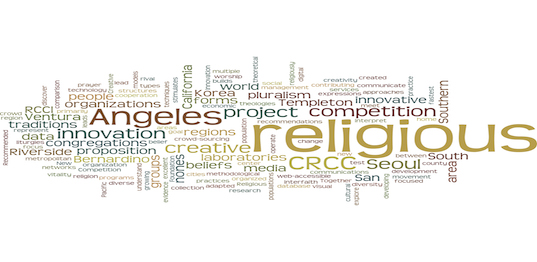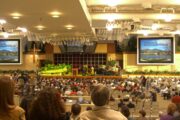The Religious Competition and Creative Innovation project (RCCI) explores the proposition that competition between religious groups stimulates creative innovation, contributing to religious change and development. The project will address key questions about the role of competition, both between and within different religious groups that have been underreported or that are beyond the scope of religious market analyses of religion.
The project builds on research that the Center for Religion and Civic Culture (CRCC) has conducted on religion throughout Southern California and on global Pentecostalism—the world’s fastest growing religious movement. But the focus of RCCI will capture multiple religious traditions and encompass two specific geographic areas: Southern California and Seoul, South Korea. We will create novel methodological approaches, including new data collection techniques and web accessible visual database technology, as well as theoretical models that can be adapted to different cities or regions around the world.
Funded by the John Templeton Foundation, RCCI intends to move beyond analyses of religious competition that focus on gain or loss in membership and to discover the various types and expressions of religious competition and cooperation, as well as how these may lead to innovative forms of religious belief, practice and organization.
The dominant theoretical paradigm related to religious competition focuses on “winners” and “losers” in terms of growth rates and numerical size. From this point of view, “religious consumers” rationally weigh the costs and benefits of joining, leaving or staying in a particular religious organization. Similarly, in this framework, religious organizations constantly seek to develop religious products that will set them apart from other religious organizations in order to attract more consumers to their particular brand of religion.
While religious market approaches have provided important insights about why some religious groups are more successful competitors than others in the religious marketplace, these studies have generally remained at the macro level. That is, they rely primarily on different forms of quantitative data comparing nations, or other large regions, to show how competition between religious groups leads to growth, decline and/or failure.
What is left out of these analyses are insights into real people and real religious groups that practice religion in the context of particular communities, and the extent to which competition organizes or motivates their activities and strategic planning. Thus, based on these studies, we know little about how individuals make decisions regarding their religious commitments or how congregational leaders creatively address the social and spiritual needs of their members.
Although during the 1980s and 1990s religious market theories were the dominant interpretive model for social scientific studies of religion. Over the past decade this dominance has been greatly reduced; now this perspective is just one among several different approaches to analyzing and understanding religion. Indeed, several recent articles have called for the development of new theoretical approaches to the study of religion. Each of these proposals suggest different ways that this novel theorizing might be accomplished, but all emphasize the need for more qualitative studies that are focused on religious organizations, practice and the social context in which religious groups operate, in order to advance our understanding of how religion “works” in the world.
We have identified two promising strategies that will shape our interpretive theoretical framework. First, we will focus on a cultural analysis that takes seriously religious practice, agency, power and interests, rather than an approach that emphasizes rational choice. Second, we will include in our analysis an investigation of the importance of geographic context—or “place” as geographers have called it—for understanding how religious action (including competition, cooperation and innovation) is either constrained or encouraged, both for religious organizations and individuals.
Thus, by employing cultural approaches to religious competition, cooperation and creative innovation, and by emphasizing the social context—place—in which religion is practiced, we will develop new theoretical insights into how competition is related to creative innovation in religious belief, practice and organization.
RCCI will be developed and primarily focused on Southern California, while developing a comparison with Seoul, South Korea. Los Angeles, a region with over 20 million people, is one of the most religiously diverse populations in the world. The Seoul metropolitan area, with a population of 24 million people, forms the cultural and economic center of South Korea, and includes a wide diversity of religious groups, which in many ways rival the religious vitality of Los Angeles. Together, these two regions are excellent laboratories within which to test the proposition that religious competition leads to creative innovation.
Why Los Angeles?
The Southern California region, stretching from Santa Barbara to San Diego, comprises over 20 million residents and accounts for 60 percent of the population of the state of California. Over 15,000 religious congregations flourish in the six counties that comprise this region (Los Angeles, Orange, Ventura, San Bernardino, Riverside and San Diego).
Southern California is a religious marketplace with a history of producing innovative religious groups and individuals, such as Aimee Semple McPherson (Angelus Temple), Robert Schuller (Crystal Cathedral), John Wimber (Vineyard), Chuck Smith (Calvary Chapel), Rick Warren (Saddleback Church) and Matthew Barnett (Dream Center). All of these movements are within the Christian tradition, but Southern California has also been fertile ground for a number of New Religious Movements (NRMs), including the Self-Realization Fellowship, Science of Mind (Religious Science) and various branches of Theosophy.
In addition, the region is home to large, thriving and innovative Jewish synagogues, Hindu and Buddhist temples and a growing number of mosques and Islamic centers. Many groups across these traditions and movements have flourished, others have languished and some have failed after several years of successful operation.
Los Angeles, where over 100 languages are spoken in the homes of students enrolled in public schools, is also a destination for new immigrants, many of whom worship at one of thousands of different congregations that serve particular immigrant and ethnic groups in the Southland. Within these congregations there is often competition that leads to leadership opportunities for new spiritual visionaries, who often develop novel expressions of doctrine, religious practice and community. Moreover, generational conflicts within immigrant and ethnic congregations often lead young adults to create alternative forms of religious practice that compete with the tradition-bound ethos of their parents.
Its history of religious innovation both within and between different religious traditions makes Southern California an ideal location in which to pursue to this project.
Why Seoul?
The Seoul metropolitan area forms the cultural, commercial, financial, industrial and demographic center of South Korea. Seoul has been an economic and religious hub since the mid 20th century, providing an ideal social setting for an array of religious movements. Its population of approximately 24 million accounts for nearly half of the total population of the country.
There range of religious groups in the region includes Protestantism, Roman Catholicism and Buddhism as well as New Religious Movements such as Cheondogyo, Korea Soka Gakkai International (KSGI) and Won Buddhism, among others. The Seoul metropolitan area is home to world-famous Christian megachurches such as Yoido Full Gospel Church (YFGC), Kumnan Methodist Church and Onnuri Church. In short, just as in Los Angeles, some congregations across these traditions and movements have thrived, others have diminished and some have failed altogether in the distinctive social and cultural ecology of the Seoul metropolitan area.
About The John Templeton Foundation
The John Templeton Foundation serves as a philanthropic catalyst for research and discoveries relating to the Big Questions of human purpose and ultimate reality. The foundation supports work at the world’s top universities in such fields as theoretical physics, cosmology, evolutionary biology, cognitive science and social science relating to love, forgiveness, creativity, purpose and the nature and origin of religious belief. It also seeks to stimulate new thinking about freedom and free enterprise, character development and exceptional cognitive talent and genius.



